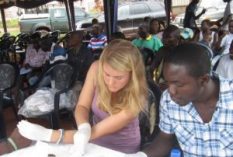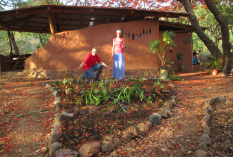Initially, the cost of going overseas can be intimidating. But once you realize how many millions of dollars are out there to help students study, volunteer, and work abroad, you’ll start getting focused on how to channel some of that money your way.
By mastering these practical tactics, you can vastly improve your chances of getting a scholarship and making your dreams of going abroad a reality.
Managing the Market
There are thousands of scholarship opportunities out there, but you have to know where to find them.
Most scholarships and grants fall into the following categories:
- Destination-based: These are awarded based on where you want to study abroad.
- Industry-specific: Some scholarships are only for students of engineering, diplomacy, public health, etc.
- Demographic: Based on ethnic background, minority statuses, gender
- Academic: Some scholarships focus more on awarding applicants with high grades or class ranking.
- Language study: Many awards are available for students learning foreign languages, especially “critical languages” like Chinese, Arabic, Farsi, etc.
- Need-based: For students with demonstrated financial need, often recipients of federal loans or grants for their university tuition.
- Program-specific: Awarded to participants of a certain program.
- University-specific: Only students from a particular university are eligible.
A good place to get started navigating this scholarship market is by visiting your university’s study abroad and/or financial aid office to ask about funding sources that may be available to you. And of course check out our own compilation of 50 Scholarships and Grants for Study, Volunteer, and Travel Abroad.
FastWeb is also a great database.
If you’re a US citizen, check out the US Department of Education FAFSA website — government grants and loans can actually be applied to study abroad, too. For students of other countries, make sure to check with your own government and the government of the country you’re planning on visiting for other funding opportunities. Many governments award money to foreign students studying at their universities, you just have to look.

Managing the Process
Applying to multiple scholarships is a process and you have to stay organized. The following tips summarize how to structure your approach to scholarship-hunting.
Start early
Start your scholarship search 3-6 months before you plan to travel abroad. You may even want to start looking a full year in advance so you have an idea of all the opportunities you’ll be eligible for. It’s never too early — but it’s also never too late either.
Apply to as many scholarships as you qualify for
Scholarships are a bit of a numbers game. Once you’ve developed a strong application, you have to make sure you put your name in as many hats as possible.
Plus, there’s no limit to the number of individual scholarships you can receive. By getting a $500 grant from one organization and $1,000 from another, you’ve covered half the cost of your dream volunteer program.
And remember, no amount is too small! It all adds up.
Check eligibility requirements carefully
Before you go around turning in applications left and right, make sure you’re applying to the right opportunities. Many scholarships have very specific requirements, from the citizenship and financial need of an applicant to their major or regional focus.
Have a system of prioritization
You’re busy, so you have to be realistic about how many scholarships you can actually apply to. Prioritize the opportunities where you meet most or all of the selection criteria, scholarships that offer a higher award amount, or programs where there may be fewer people applying because they are obscure or very specific, ie. an award for Irish-Americans who are also first generation college students. If you fit that criteria, make sure you apply!
Keep track of deadlines
It sounds very basic, but make sure you apply on time to be considered. We recommend setting up a basic Excel spreadsheet where you track the name, eligibility criteria, deadline, application requirements, and selection criteria for every opportunity you plan to apply for. Staying organized will help you stay sane!
Prepare your references
You’ll probably be asked to provide one or two references for each scholarship application. Do everyone involved a favor by prepping those references carefully (and professors will be happy to recommend you to multiple opportunities if you make it easy for them).
Create a document with the name of the scholarship(s) you’re applying for, a few sentences about what it is and what their selection criteria is, the deadline for submitting their reference letter clearly highlighted, and a short paragraph summarizing why you’re the right candidate for that opportunity. Print this document out, attach your resume, and bring it to that person (with a smile). Make sure you follow-up and politely remind them a few days before a deadline.

Managing the Application
Now that you have a strategy for the application process, you need to make sure your applications themselves are outstanding. Here are specific tips on how to make sure you’re submitting the best possible application.
Address the selection criteria explicitly
Most scholarships specify exactly what they are looking for. You’d be smart to print that list off and check off each one as you address it in your application. Make it easy for them to see you’re the candidate they’re looking for!
Look at the organization’s values
You want to tailor each application to its audience, so do your homework. Study the organization’s website: How do they talk about themselves? What’s their tone of voice? What values are important to them? What’s their mission statement? Then reflect those things back to them in a way that’s still authentically you. You can also review the profiles of past scholarship recipients (they are often listed right on the website).
Address your past, present, and future
A smart applicant will strategically place examples throughout their application that address the parts of her past, present, and future that relate to that opportunity. Let’s say a student is applying for a scholarship to study Mandarin in China. She may briefly share a story of a childhood friend from China who got her interested in Asian cultures and languages, she will highlight what she’s doing now to advance her language skills (it’s important to show you’re already applying yourself), and then she shares a thoughtful plan about how that program and opportunity will advance her studies and shape her career in the future.
Showing the full “life cycle” of interest in this opportunity hugely increases your chances of resonating with the selection committee.
Give specific examples
Stay away from generalities. Of course you are smart and hard-working, but what makes you stand out from all the other applicants? Create a list of at least five qualities or experiences that make you unique and find a way to highlight those things in every application (as long as they are relevant).
Also: show, don’t tell. Don’t tell them you’re interested in the Middle East, share the example of how you work with refugees on the weekend.
How will you give back?
Most scholarships want to see that you understand that there’s a privilege with receiving a grant to travel abroad and showing an attitude of humility and gratitude for even the possibility of that experience is warmly received.
Even if not explicitly stated in the application, sharing ideas for how you will use your experience overseas to give back to your home community will win you major points with most selection committees. It’s also a great thing to actually do, whether or not you win a scholarship to travel.
Read it out loud
The easiest way to prevent typos and other mistakes is to print out your application essays in hard copy and read them word-for-word out loud, preferably in front of an audience. You’ll catch grammatical errors, awkward wording, incomplete sentences, and typos this way — guaranteed.

Final Words of Wisdom
Remember, where there’s a will, there really is a way. If you have your heart set on volunteering in Kenya or studying Portuguese in Brazil or interning with an NGO in Indonesia, you will make it happen.
Inevitably, you will not receive every scholarship you apply for, so take the rejection in stride. By putting yourself out there for every opportunity you can, you vastly increase your chances of being recognized and awarded real dollars towards your goal.
So don’t give up — and never give up your dreams of going abroad because of something like money, which can be resolved with a little time, strategy, and know-how.
Now that you know how, check out our list of 50 Scholarships & Grants that you can apply to!












